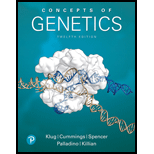
Concept explainers
In a sequence encompassing 99.4 percent of the euchromatic regions of human chromosome 1, Gregory et al. [(2006) Nature 441:315–321] identified 3141 genes.
- (a) How does one identify a gene within a raw sequence of bases in DNA?
- (b) What features of a genome are used to verify likely gene assignments?
- (c) Given that chromosome 1 contains approximately 8 percent of the human genome, and assuming that there are approximately 20,000 genes, would you consider chromosome 1 to be “gene rich”?
(a)
To determine: The ways by which an individual can identify a gene within a raw sequence of bases in DNA.
Introduction: The bioinformatics includes the use of computer hardware and software, mathematics applications to organize, share and analyze data that is related to gene structure, gene sequence and expression; and protein structure and function.
Explanation of Solution
To annotate a gene, an individual identifies gene-regulatory sequences such as promoters, enhancers, and silencers that are found upstream of genes. A person can also identify downstream elements such as termination sequences and in-frame triplet nucleotides that are part of the coding region of the gene. Moreover, 5’ and 3’ splice sites are also used. These splice sites distinguish exons from introns. The polyadenylation sites can also be used in annotation.
Thus, a person can identify a gene from the raw sequence of bases by identifying gene-regulatory sequences and the downstream elements.
(b)
To determine: The characteristics of a genome which are used to verify similar gene assignment.
Introduction: Gene is a unit of DNA that is present on a chromosome. It controls the development of one or more traits. The gene is the basic unit through which genetic information is passed from parent to offspring.
Explanation of Solution
The similarity to other annotated sequences provides an approach to a sequence’s functions, and it confirms a particular genetic assignment. Direct sequencing of cDNAs from various tissues and developmental stages aids in verification.
Thus, direct sequencing of cDNAs of a genome is used to verify similar gene assignment.
(c)
To determine: Whether the chromosome 1 will be considered as “gene rich” provided that it contains approximately 8 % of the human genome and 20,000 genes.
Introduction: The human genome is referred to as the genome of Homo sapiens. The human genome consists of 23 pairs of the chromosome with a total of about 3 billion DNA base pairs.
Explanation of Solution
The 3141 genes identified on chromosome 1which constitute 15.7 % of the total number of genes in the human genome (estimated to be 20,000). As per the given information, chromosome 1 contains 8 % of the human genome and nearly 16 % of the genes; one can say that chromosome 1 is “gene rich”.
Want to see more full solutions like this?
Chapter 21 Solutions
Concepts of Genetics (12th Edition)
- Explain how the hormones of the glands listed below travel around the body to target organs and tissues : Pituitary gland Hypothalamus Thyroid Parathyroid Adrenal Pineal Pancreas(islets of langerhans) Gonads (testes and ovaries) Placentaarrow_forwardWhat are the functions of the hormones produced in the glands listed below: Pituitary gland Hypothalamus Thyroid Parathyroid Adrenal Pineal Pancreas(islets of langerhans) Gonads (testes and ovaries) Placentaarrow_forwardDescribe the hormones produced in the glands listed below: Pituitary gland Hypothalamus Thyroid Parathyroid Adrenal Pineal Pancreas(islets of langerhans) Gonads (testes and ovaries) Placentaarrow_forward
- Please help me calculate drug dosage from the following information: Patient weight: 35 pounds, so 15.9 kilograms (got this by dividing 35 pounds by 2.2 kilograms) Drug dose: 0.05mg/kg Drug concentration: 2mg/mLarrow_forwardA 25-year-old woman presents to the emergency department with a 2-day history of fever, chills, severe headache, and confusion. She recently returned from a trip to sub-Saharan Africa, where she did not take malaria prophylaxis. On examination, she is febrile (39.8°C/103.6°F) and hypotensive. Laboratory studies reveal hemoglobin of 8.0 g/dL, platelet count of 50,000/μL, and evidence of hemoglobinuria. A peripheral blood smear shows ring forms and banana-shaped gametocytes. Which of the following Plasmodium species is most likely responsible for her severe symptoms? A. Plasmodium vivax B. Plasmodium ovale C. Plasmodium malariae D. Plasmodium falciparumarrow_forwardStandard Concentration (caffeine) mg/L Absorbance Reading 10 0.322 20 0.697 40 1.535 60 2.520 80 3.100arrow_forward
- please draw in the answers, thank youarrow_forwarda. On this first grid, assume that the DNA and RNA templates are read left to right. DNA DNA mRNA codon tRNA anticodon polypeptide _strand strand C с A T G A U G C A TRP b. Now do this AGAIN assuming that the DNA and RNA templates are read right to left. DNA DNA strand strand C mRNA codon tRNA anticodon polypeptide 0 A T G A U G с A TRParrow_forwardplease answer all question below with the following answer choice, thank you!arrow_forward
 Biology: The Dynamic Science (MindTap Course List)BiologyISBN:9781305389892Author:Peter J. Russell, Paul E. Hertz, Beverly McMillanPublisher:Cengage Learning
Biology: The Dynamic Science (MindTap Course List)BiologyISBN:9781305389892Author:Peter J. Russell, Paul E. Hertz, Beverly McMillanPublisher:Cengage Learning Biology 2eBiologyISBN:9781947172517Author:Matthew Douglas, Jung Choi, Mary Ann ClarkPublisher:OpenStax
Biology 2eBiologyISBN:9781947172517Author:Matthew Douglas, Jung Choi, Mary Ann ClarkPublisher:OpenStax Human Heredity: Principles and Issues (MindTap Co...BiologyISBN:9781305251052Author:Michael CummingsPublisher:Cengage Learning
Human Heredity: Principles and Issues (MindTap Co...BiologyISBN:9781305251052Author:Michael CummingsPublisher:Cengage Learning Concepts of BiologyBiologyISBN:9781938168116Author:Samantha Fowler, Rebecca Roush, James WisePublisher:OpenStax College
Concepts of BiologyBiologyISBN:9781938168116Author:Samantha Fowler, Rebecca Roush, James WisePublisher:OpenStax College BiochemistryBiochemistryISBN:9781305577206Author:Reginald H. Garrett, Charles M. GrishamPublisher:Cengage Learning
BiochemistryBiochemistryISBN:9781305577206Author:Reginald H. Garrett, Charles M. GrishamPublisher:Cengage Learning Biology Today and Tomorrow without Physiology (Mi...BiologyISBN:9781305117396Author:Cecie Starr, Christine Evers, Lisa StarrPublisher:Cengage Learning
Biology Today and Tomorrow without Physiology (Mi...BiologyISBN:9781305117396Author:Cecie Starr, Christine Evers, Lisa StarrPublisher:Cengage Learning





